North Dublin, Co. Dublin
Up to 1838
Following a parliamentary Act of 1703, Dublin's first House of Industry was established on a site to the south of the River Liffey near (Saint) James's Street. Although the establishment's inmates included 'sturdy beggars', 'disorderly women', and the old and infirm, its main activity became that of the city's Foundling Hospital, receiving large numbers of orphaned or abandoned children.
Following an Act of 1772 (11 & 12 Geo. III c.11), a new House of Industry was established an 11.5-acre site on the north side the Liffey, at the north side of North Brunswick Street. Its role was to be divided into four parts:
- One to be allotted to such poor helpless men as should be judged worthy of admission;
- For the reception of such poor helpless women as should be judged worthy of admission
- For the reception of men who should be committed as vagabonds or sturdy beggars able or fit for labour
- For such idle, strolling, and disorderly women as should be committed and found able or fit for labour.
A large complex of buildings subsequently evolved around the new House of Industry including:
- An asylum for aged and infirm poor
- An asylum for incurable lunatics
- The Bedford Asylum for the reception of children
- The Hardwicke Fever Hospital
- The Whitworth Hospital for chronic medical patients
- The Richmond Surgical Hospital
- The Talbot Dispensary which provided medical and surgical relief to the extreme poor of the north-west quarter of the city, numbering over 300 a week.
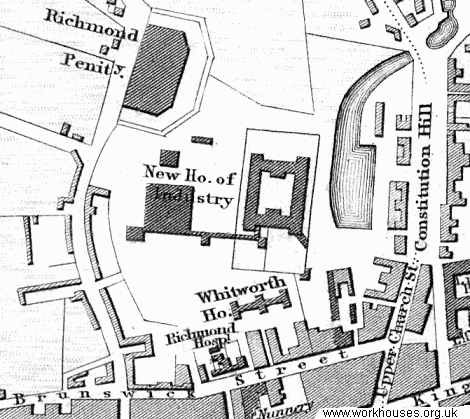
North Dublin workhouse site, 1836
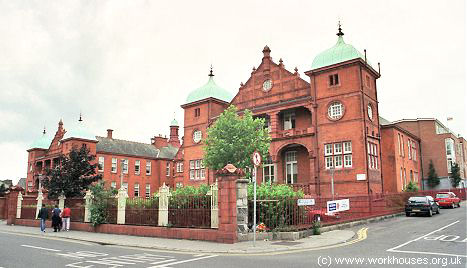
Richmond Hospital from the south-east, 2003
© Peter Higginbotham.
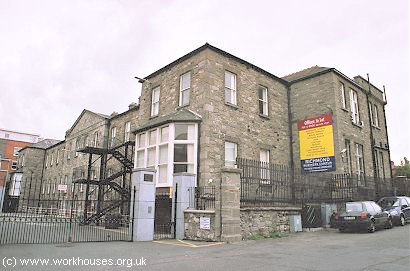
Whitworth Hospital from the south-east, 2003
© Peter Higginbotham.
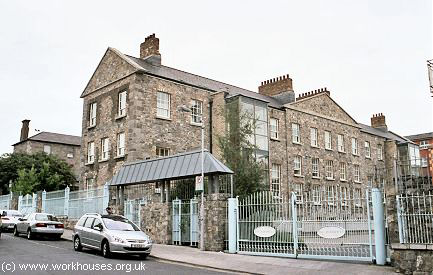
Hardwicke Hospital from the south-west, 2003
© Peter Higginbotham.
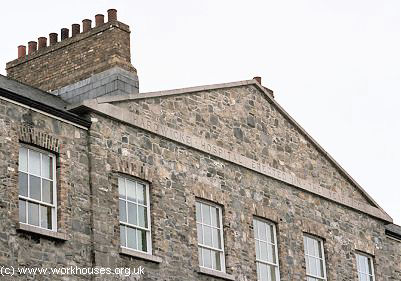
Hardwicke Hospital from the south-west, 2003
© Peter Higginbotham.
In the 1790s, the workhouse was issuing its own copper coinage, the reason for which is unclear. One possibility is that it was issued as "pocket money" to inmates in return for their labour, with restrictions on how or where it could be spent.
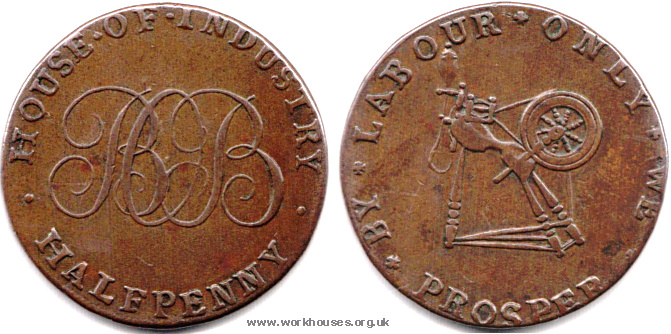
A House of Industry token, c.1795.
The House was originally intended to be funded by voluntary contributions, but these soon proved insufficient and from 1777 it received a parliamentary grant initially of £4,000 per annum. By 1839 this had risen to over £20,000 per annum, at which time the House contained 1665 inmates:
- 888 aged and infirm poor
- 474 incurable lunatics and epileptics
- 303 Sick in the hospitals
"Curable" lunatics, on the other hand, might be placed in the Richmond Lunatic Asylum, immediately adjacent to the House of Industry, opened in 1814. This institution provided treatment for pauper lunatics from throughout the country.
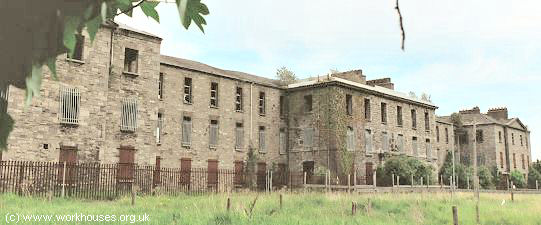
Richmond Lunatic Asylum from the south-west, 2002
© Peter Higginbotham.
After 1838
North Dublin Poor Law Union was formally declared on the 6th June 1839 and covered an area of 60 square miles. Its operation was overseen by an elected Board of Guardians, 33 in number, representing its 9 electoral divisions as listed below (figures in brackets indicate numbers of Guardians if more than one):
Co. Dublin: North City (18), Howth (2), Blanchardstown, Castleknock (2), Clontarf (2), Coolock (2), Drumcondra (2), Finglas (2), Glasnevin (2).
The Board also included 11 ex-officio Guardians, making a total of 44. The population falling within the Union at the 1831 census had been 124,425 with Divisions ranging in size from Blanchardstown (population 1910) to North City (100,273).
The part of Dublin to the south of the River Liffey formed the separate South Dublin Poor Law Union.
The Poor Law Commissioners published a map of the new North Dublin union in their 1840 Annual Report:
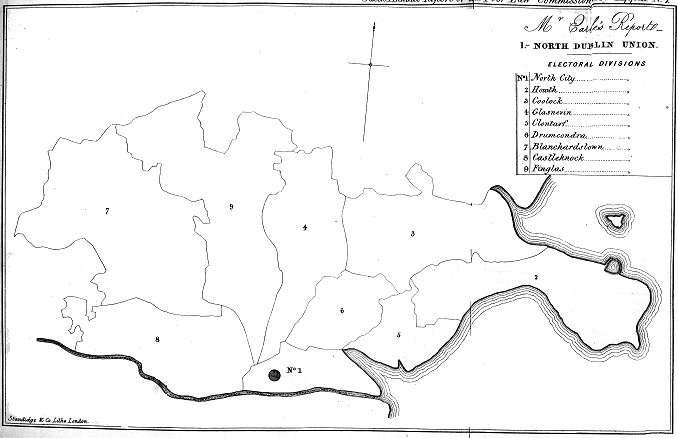
North Dublin Union, 1840
The existing House of Industry was adapted under the supervision of the Commissioners' architect George Wilkinson. The building work cost £4,819 plus £3,180 for fittings etc. It was intended to accommodate up to 2000 inmates as follows:
- 250 aged and infirm males
- 200 able-bodied and partially infirm males
- 350 boys
- 350 aged and infirm females
- 300 able-bodied and partially infirm females
- 350 boys
- 200 sick in the hospitals and violent lunatics in cells
Pauper lunatics were not to be accommodated in the Union workhouse and 370 transferred from the existing premises to former artillery barracks at Island Bridge.
The new workhouse accommodation was formally declared fit for the reception of paupers on 25th March, 1840, with the first admissions taking place on May 4th. The layout of the site soon after its conversion is shown on the 1849 map below:
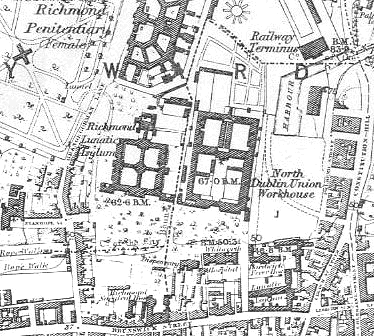
North Dublin workhouse site, 1849.
Apart from some additions at the north, the site was relatively unchanged sixty years later as shown on the 1907 map below.
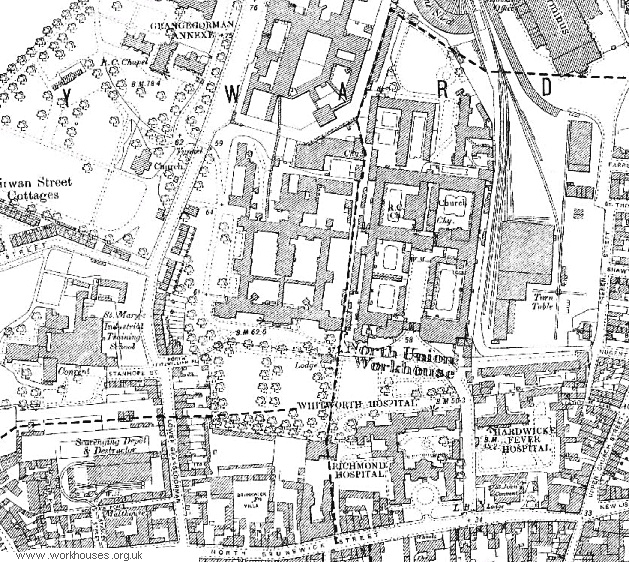
North Dublin workhouse site, 1907.
In 1844, German traveller J.G. Kohl published an account of his travels through England, Scotland and Ireland. On his visit to Ireland he visited the North Dublin workhouse and described the inmates' food and clothing:
The food and clothing within an Irish workhouse is certainly better than the pauper could enjoy out of it, for of course the inmates of such a house are not allowed to go about half-naked and half-starved, the usual condition of the poor in Ireland. The food consists generally of potatoes, oatmeal, and milk, particularly buttermilk. Bread is given only to the children and the sick. The diet tables and other regulations of public institutions are of interest to the inquiring traveller, for they often afford him a convenient insight into the manner of life of a whole nation. When, therefore, I detail to my readers the fare of a pauper in an Irish workhouse, I give them a picture of the style of living of the great mass of the Irish people, of those at least among them who have it in their power to eat their daily fill.
As among most classes in Ireland and England, the day is divided into three acts or meals, breakfast, lunch, and dinner. By the last is not to be understood the noonday meal, but the chief meal of the day. The lunch is participated in only by the children and invalids. The healthy and full-grown are excluded from it. The hours at which these meals are taken are later than with us in Germany. Nine o'clock is the hour for breakfast, and four in the afternoon for dinner. The breakfast, as in most parts of Ireland, among those who have the means of decent maintenance, consists of new milk and stirabout, a kind of porridge of oatmeal; the dinner is composed of potatoes and buttermilk. The children, for their lunch, receive bread and milk. On Sundays, holidays, and on every Thursday, a little brose, or soup, is given, in addition to the customary diet. An adult receives seven ounces of oatmeal and half a pint of new milk for breakfast, and four pounds of potatoes and a pint of buttermilk for dinner. The board of an adult is calculated to cost one shilling and fourpence three-farthings weekly. That of the children is more expensive, on account of the bread, and the more liberal supply of milk. The most costly of all is the board of the children under two years old, who cost one shilling and sixpence three-farthings a week, for which they receive one pint of new milk and a pound of bread daily. There is therefore a potato diet for adults, a bread diet for children, a rice and meat diet for the sick, and lastly, a fever diet for the class of patients always most numerous in an Irish workhouse.
I was astonished by the appearance of the potato-kettle at this house. No less than 1670 pounds of potatoes are boiled at once. This enormous quantity is all divided into portions of three and a half and four pounds, and each portion is enclosed in a small net. All these nets are laid together in a large basket, and this basket, with its nets and potatoes, is deposited in the boiler. When the potatoes are supposed to have been sufficiently boiled, the basket is wound up again by a machinery, constructed for the purpose, and the poor are then marched up in military order, when each receives his net and marches away with it.
In the school, belonging to this house, the Chinese-Russian calculating board, or numerical frame, had already been introduced, but only a fortnight before my arrival.
Most of the people were employed picking oakum, the occupation assigned to the inmates of most of the prisons and workhouses of England, who are thus made to prepare lint for the wounds of the British men of war. This article is indispensable in the dockyards, where it is used for calking ships. Hundreds of thousands of hands are daily occupied in the workhouses, and houses of correction, in untwining old rope ends for this purpose.
One of the most interesting parts of the establishment is the old clothes store, in which the variegated rags that the paupers bring with them are carefully preserved, to be returned to them on their departure. A pauper, on entering the house, receives in exchange for his motley drapery, the gray uniform of the house, with N.D.U.W.H. (North Dublin Union Workhouse) embroidered upon it in large letters. His liberty rags, together with hat, stockings, shoes, &c., are first carefully fumigated, and then, having been folded together, are marked with the name of their owner, and. deposited in the old clothes store. The pauper may at any time have his discharge, by simply intimating a wish to that effect to the governor, but to allow him to take with him the clothes worn in the workhouse would never do, or many would enter one day and go away again the next, merely for the sake of a new suit of apparel. Their old rags are therefore restored to them, and their ingenuity is again. taxed to discover the right entrance to their distorted sleeves. It happens almost every day that among the 2000 inmates of the house, one or other, weary of discipline and confinement, and longing for his former liberty, gives the governor notice to quit, and demands the restitution of his wardrobe. It so happened that, at the period of my visit, such an application had just been made, and the clothes store was, in consequence, open. All the theatres in Europe could not have matched, in point of variety, the wardrobe here displayed to me.
In 1895, the workhouse was visited by a "commission" from the British Medical Journal investigating conditions in Irish workhouse infirmaries. Their report noted that North Dublin had separate infirmaries for Roman Catholic and Protestant patients, the former being staffed by nuns who had received no formal medical training, and with a large number pauper inmates acting as nursing assistants. As well as the lack of trained nurses, the report criticised the state of the patients' accommodation — the female luntaics were said to be housed "in quarters better fitted for animals than for human beings." Further details are available in the full report. The BMJ's revelations contributed to the introduction of significant improvements in the standard of Irish workhouse nursing, with the employment of pauper inmates ending ending after the passing of 1898 Local Government Act.
In 1918, the North Dublin union was amalgamated with South Dublin, the joint union being named the Dublin Union and based at the former South Dublin site. The old North Dublin workhouse was then taken over for use by the British military, which continued until 1922.
The main workhouse building has now been demolished apart from two small buildings at the southern entrance to the site.
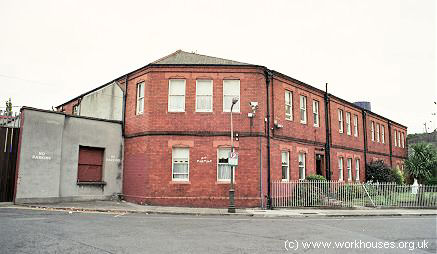
Dublin workhouse from the south-west, 2003
© Peter Higginbotham.
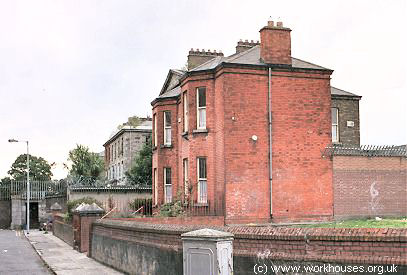
Dublin workhouse from the south-east, 2003
© Peter Higginbotham.
St Vincent's Home
The North Dublin union operated a separate poor law school, known as St Vincent's Home, at Cabra, on the south side of the Navan Road, alongside Dublin's Phoenix Park. The South Dublin union's Pelletstown school stood a few hundred yards away to the north-west. In 1914, the two schools housed a total of 635 children.
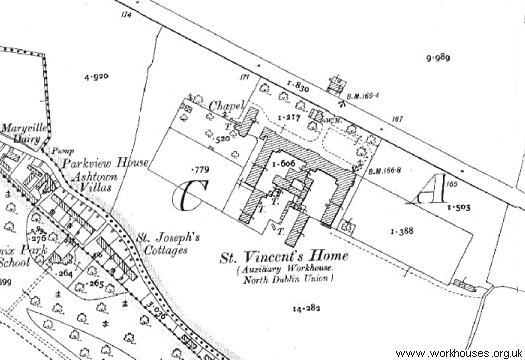
North Dublin workhouse school site, 1907.
In 1888, the operation of St Vincent was taken over by an order of Dominican nuns. By 1893, they had been replaced by the Daughters of Charity of St Vincent de Paul.
Below is a report on the Cabra establishment from 1897.
THE AUXILIARY WORKHOUSE AT CABRA.
The auxiliary workhouse at Cabra is exclusively for children, and an average of about 430 are inmates there. Since the Sisters of Charity have had charge of the place its internal arrangements and the system on which the institution is worked, have been quite revolutionised. Today the establishment is as unlike a workhouse as can well be conceived. It goes without saying that the little ones are well cared for — that the order, cleanliness, and neatness of the establishment are beyond reproach or cavil, and that the teaching system is all that can be desired. To every one who knows the work of the Sisters of Charity mere mention of the fact that the institution is in their charge includes the statement of the excellence with which it is conducted. But over and above the routine of management and tuition ordinarily associated with an establishment of the kind, the Sisters have introduced a system of manual instruction as complete as is to be found in any training institution through the country, and surpassing, and indeed utterly unlike, anything existing in connection with workhouses in Ireland.
To accomplish this some outlay on the part of the Guardians was necessary. The result has shown the wisdom of the few earnest men on the board who helped the nuns to carry out the system of reform that they had initiated. For now the children, under the system of instruction pursued, do all the necessary work of the establishment, for which the Guardians had formerly to provide out of the rates, With the single exception of boots, all the clothing that the children wear is manufactured by themselves. They do all the washing and cooking. They raise their own vegetables on the farm. All this represents a very considerable saving to the ratepayer. The economical advantages of the system do not end here. Those who have anything to do with or any knowledge of the poor law administration know the terrible pest that the workhouse-reared child becomes. The poorhouse boy or the workhouse girl developed only into the poorhouse man or the poorhouse woman. They are not merely idle and lazy; they are incapable. When the able-bodied man or woman was put outside the workhouse to try for a living outside the atmosphere of the workhouse accompanied them wherever they went. They were useless for any effort outside, and they returned in destitution to the workhouse, which was the loser for the experiment by the cost of the outfit with which it had provided them. The grown boy or girl leaves she Cabra workhouse with a taste for work and a technical training that gives that work special merit. The boys are skilled — one may say scientifically skilled — farm labourers The girls know everything that should be known about the rearing of poultry. The boys can knit large woollen garments, and are good at making matting. The girls have been practically trained to sewing both by hand and machinery. They, too, are instructed in manual aid machine knitting. Boys and girls are taught cutting as well as sewing. The girls are excellent washerwomen and good cooks. The boys have an elementary art class recently started, and their tastes are also elevated by the instruction in gardening in all its branches, both outside and inside. For the few years that the system has been working the children who have been put out in the world have given every satisfaction to their employers. One cannot cay that the Cabra trained children will all, unlike the workhouse children of the past, keep out of the workhouse in their mature years, but if anything could guarantee that they will, the training they receive most assuredly does. So far the system has worked admirably, and though one does not like to say so until the period of trial is past, still what has happened in those few years warrants the belief that the ratepayers will be benefited by being relieved of the permanent burden that the workhouse-reared man or woman has hitherto been upon the rates in his union.
The average number of children in the establishment is about 430. It varies from 390 to 450. The greater number of the children are between six and ten years old. There are others as young as four years and up to thirteen. The little things are bright and intelligent, and the newcomer is soon affected by the atmosphere of content and happiness that fills the place. Looking at them in their classes at work or at play one marvels at the astounding character of the work accomplished by the nuns. Everyone will understand the material that they have to deal with in the workhouse child. Nothing has been done for them by their parents, who must themselves be paupers before their children can enter the house. The little things are dirty, ill-nourished and untaught. Here, in a marvellously short time, all their ill habits are removed and their intel1igence is developed. Studying their special aptitudes, the nuns assign to each the task that interests. Instruction is in that way made attractive. The visitor hears that it is a drawback on the system that the children have no permanency in the establishment. He feels that it must be so. They must leave the workhouse when their parents leave. They return with them. The constant breaking up of the system — a few months in the institution, a few months in squalor outside — must seriously hamper the work of the nuns. That it does so is certain. It is difficult to realise it when the children are seen in the school. They are apt scholars; many of them commencing late with the alphabet are soon in the high standards. The different classes of work are so arranged that their life is a constant variety, and the instruction is imparted in a way that attracts and entertains, and is the more easily acquired on that account.
The Master of the North Dublin Union Workhouse hiss seconded the efforts of the nuns, and has shown a sympathetic interest in the work. The guardians deserve special commendation for so readily entering into the spirit of the undertaking. A special committee of the board to look after the interests of the establishment meets once a month.
There is a handsome chapel attached to the building; its extent is only just sufficient for the average number of the inmates.
The site was later taken over by the Daughters of Charity as a home for 'mentally defective' girls and small boys. In 2014, the building was being refurbished for new occupants.
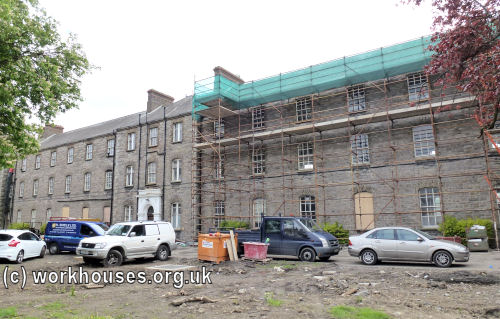
Former North Dublin Union St Vincent's School, 2014.
© Peter Higginbotham.
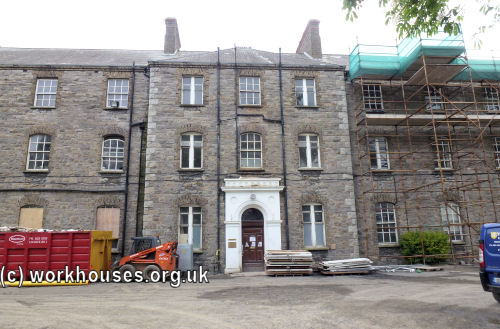
Former North Dublin Union St Vincent's School, 2014.
© Peter Higginbotham.
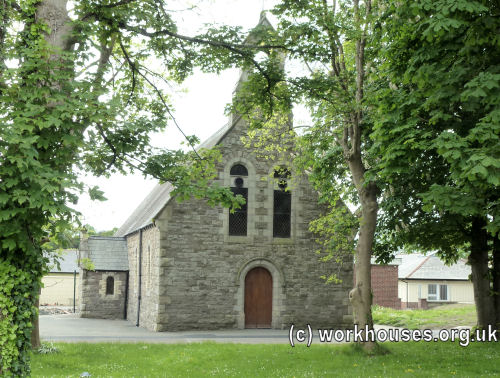
Former North Dublin Union St Vincent's School chapel, 2014.
© Peter Higginbotham.
Inmates
Records
Note: many repositories impose a closure period of up to 100 years for records identifying individuals. Before travelling a long distance, always check that the records you want to consult will be available.
- National Archives of Ireland, Bishop Street, Dublin 8.
- The North Dublin workhouse admission/discharge registers are now searchable online on [an error occurred while processing this directive] (subscription required).
Bibliography
- Corrigan, Frank (1976) Dublin Workhouses During the Great Famine (Dublin Historical Record, XXIX, No. 2, 59-65.
- Crossman, V (2006) Politics, Pauperism and Power in Late Nineteenth-century Ireland
- Gray, P (2009) The Making of the Irish Poor Law, 1815-43
- O'Connor, J (1995) The Workhouses of Ireland
Links
Unless otherwise indicated, this page () is copyright Peter Higginbotham. Contents may not be reproduced without permission.


